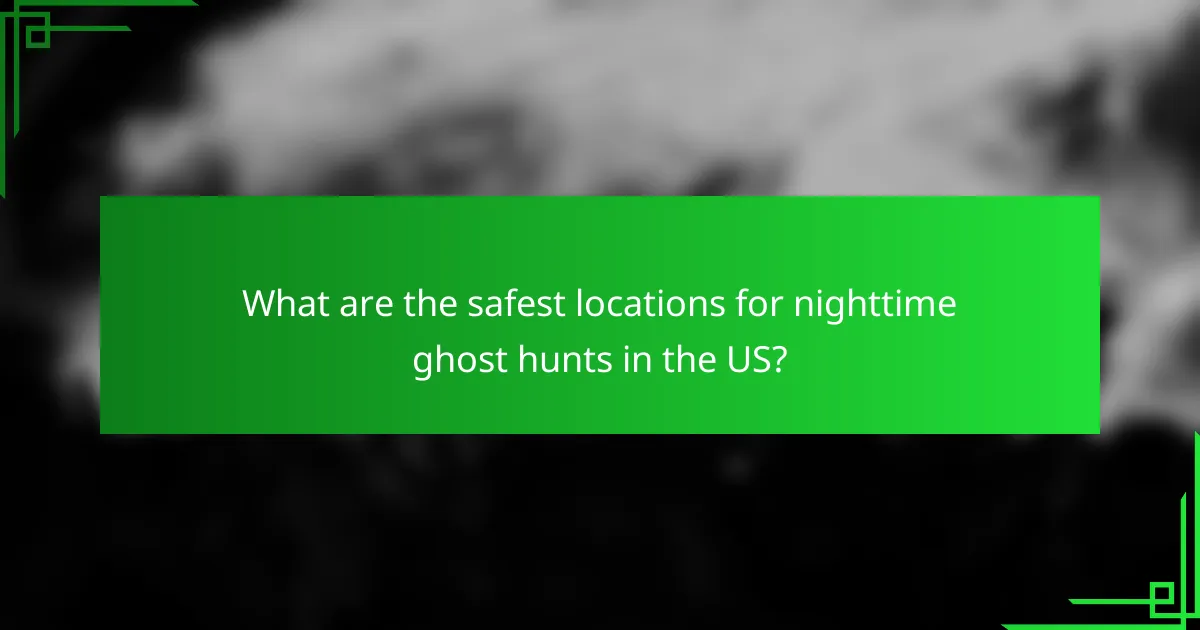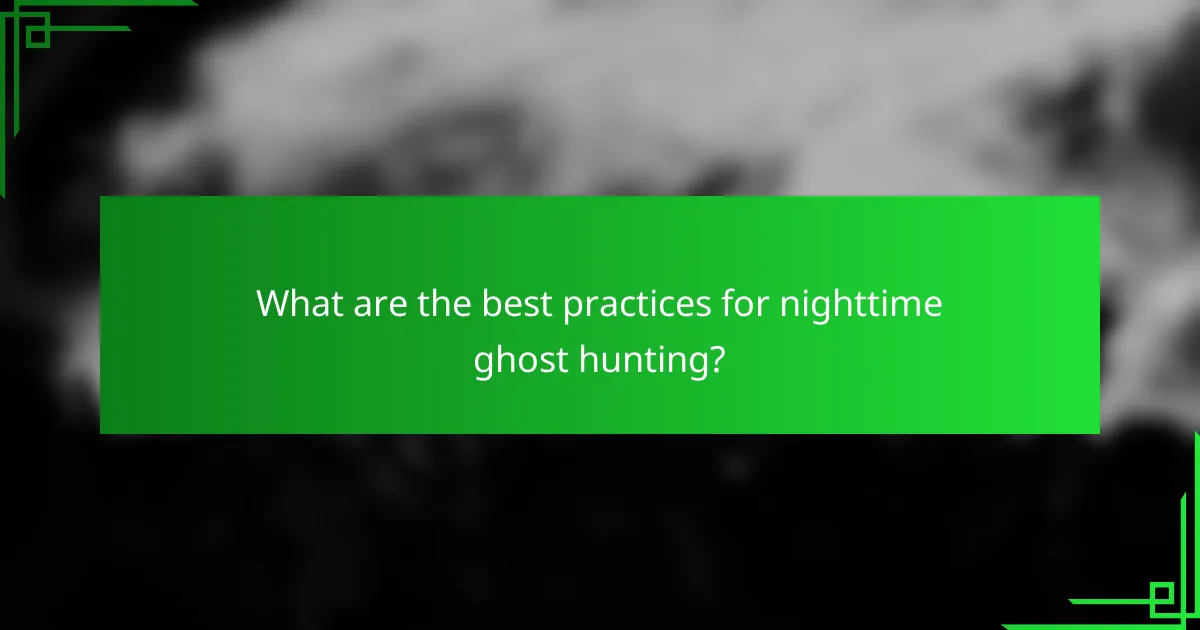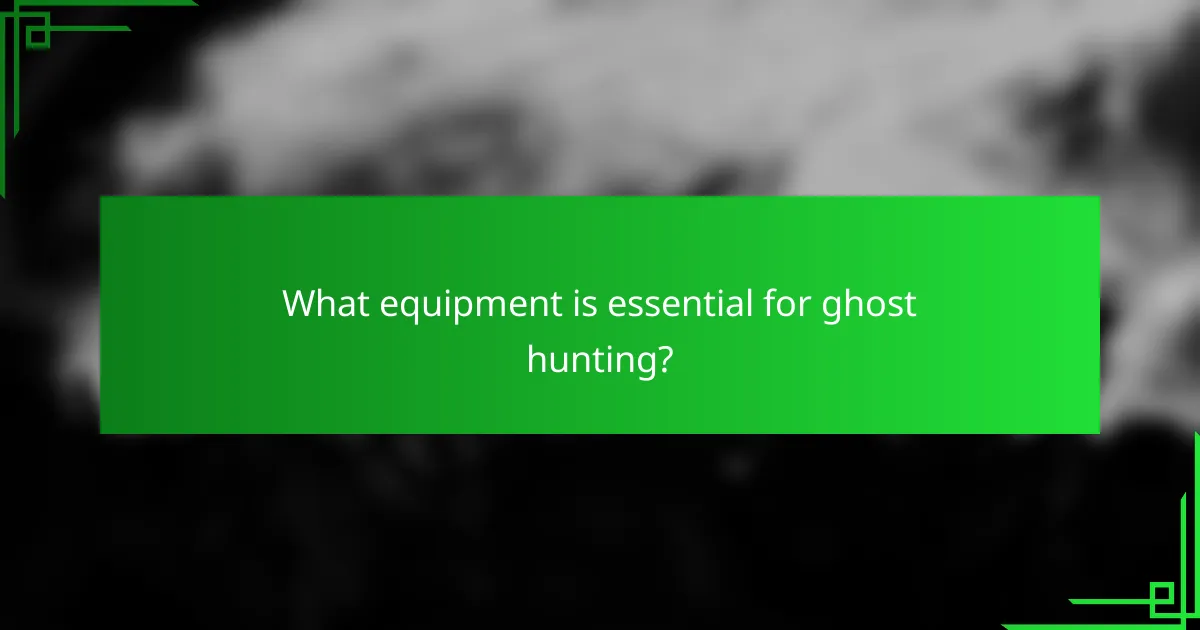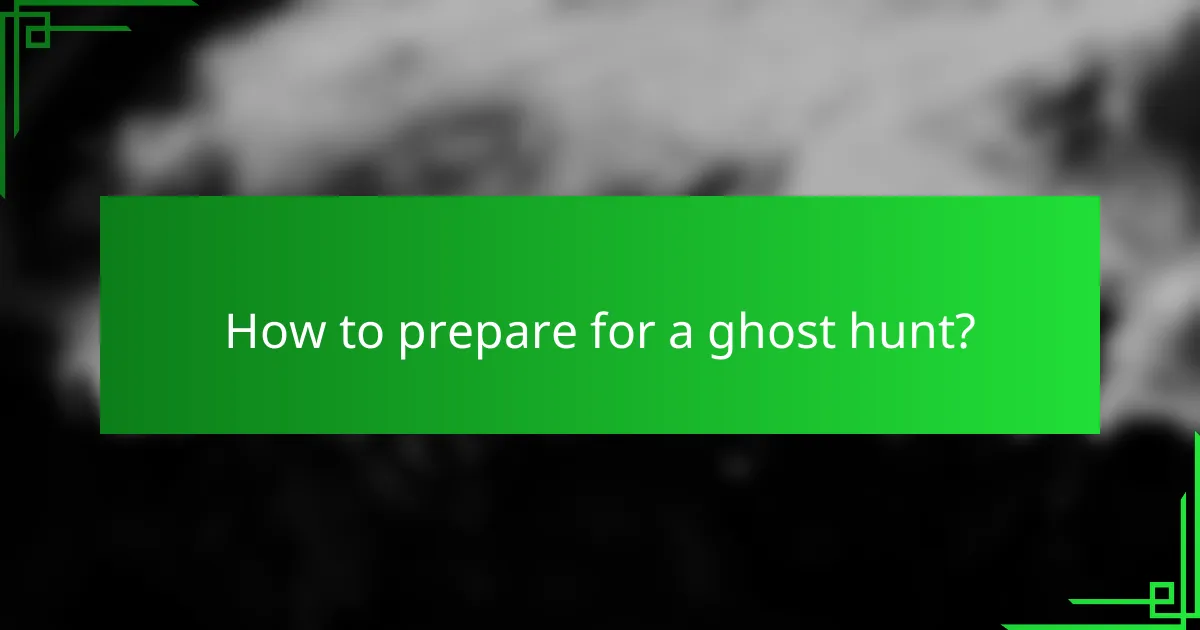When planning a nighttime ghost hunt, selecting a safe location is crucial for an enjoyable experience. Historic sites with established safety protocols not only offer the thrill of potential paranormal activity but also ensure visitor safety through guided tours and security measures. By considering factors such as historical significance, local regulations, and accessibility, you can create a responsible and memorable ghost hunting adventure.

What are the safest locations for nighttime ghost hunts in the US?
The safest locations for nighttime ghost hunts in the US are typically well-known historic sites with established safety protocols and local regulations. These areas often have a reputation for paranormal activity while ensuring visitor safety through guided tours and security measures.
Historic Savannah, Georgia
Historic Savannah is renowned for its haunted history and well-preserved architecture, making it a prime location for ghost hunts. The city offers guided tours that ensure safety while exploring sites like the Colonial Park Cemetery and the Sorrel-Weed House.
When ghost hunting in Savannah, consider joining a reputable tour company that provides knowledgeable guides and adheres to local safety regulations. This approach not only enhances your experience but also minimizes risks associated with nighttime explorations.
Gettysburg, Pennsylvania
Gettysburg is famous for its Civil War history and numerous ghost stories, attracting many paranormal enthusiasts. The Gettysburg National Military Park offers organized ghost tours that focus on safety and historical context, allowing visitors to explore haunted sites like the battlefield and the Farnsworth House.
For a safe experience, choose tours that operate with permits and have trained guides. Always stay with the group and follow any safety instructions provided to ensure a secure ghost hunting adventure.
New Orleans, Louisiana
New Orleans is steeped in supernatural lore, with locations like the French Quarter and Lafayette Cemetery No. 1 being popular among ghost hunters. The city has a variety of ghost tours that prioritize visitor safety while delving into its rich haunted history.
Opt for tours that are well-reviewed and have a strong safety record. Be mindful of your surroundings and avoid wandering alone in less populated areas at night to enhance your safety during the hunt.
San Antonio, Texas
San Antonio offers a unique blend of history and hauntings, with sites like the Alamo and the San Fernando Cathedral drawing ghost hunting enthusiasts. Many local companies provide guided tours that ensure a safe exploration of these haunted locations.
When participating in ghost hunts in San Antonio, select tours that include safety measures such as group sizes and emergency protocols. Staying with a group and following the guide’s instructions can significantly enhance your safety.
Charleston, South Carolina
Charleston is known for its charming streets and ghostly tales, with historic sites like the Battery and the Old City Jail being popular among ghost hunters. The city offers numerous ghost tours that focus on both safety and the rich history of the area.
Choose tours that are well-established and have good reviews regarding safety practices. Always remain aware of your environment and stick to well-lit areas to ensure a safe and enjoyable ghost hunting experience.

How to choose a ghost hunting site?
Choosing a ghost hunting site involves evaluating its historical significance, understanding local regulations, and ensuring accessibility and safety. These factors help ensure a successful and responsible ghost hunting experience.
Evaluate historical significance
Historical significance is crucial when selecting a ghost hunting site, as locations with rich pasts often have more paranormal activity. Look for sites with documented events, such as battles, tragedies, or notable figures associated with them.
Research local history through books, archives, or online resources. Consider visiting historical societies or museums to gather insights that can enhance your ghost hunting experience.
Assess local regulations
Before embarking on a ghost hunt, check the local regulations regarding trespassing and nighttime activities. Some locations may require permits or have specific hours when access is allowed.
Familiarize yourself with any laws that pertain to ghost hunting in your area. This may include restrictions on equipment usage, noise levels, or the presence of other individuals. Ignoring these regulations can lead to fines or legal issues.
Consider accessibility and safety
Accessibility is vital for a successful ghost hunt. Ensure that the site is reachable by your mode of transportation and that you can navigate the area safely, especially at night. Look for well-maintained paths or roads leading to the site.
Safety should be a top priority. Assess potential hazards such as wildlife, unstable structures, or difficult terrain. Bring a first aid kit and ensure that your group has a plan for emergencies. Always inform someone about your location and expected return time.

What are the best practices for nighttime ghost hunting?
Best practices for nighttime ghost hunting include thorough preparation, adherence to safety measures, and respect for locations. By following these guidelines, you can enhance your experience while minimizing risks and legal issues.
Bring appropriate equipment
Having the right equipment is crucial for a successful ghost hunt. Essential items typically include a flashlight, extra batteries, a camera, and audio recording devices. Consider using EMF meters and spirit boxes for more advanced investigations.
Before heading out, ensure all equipment is in working order and familiarize yourself with its functions. This preparation can help you capture evidence effectively and avoid technical difficulties during your hunt.
Follow safety protocols
Safety protocols are vital when ghost hunting at night. Always inform someone about your location and expected return time. Traveling in groups is advisable, as it enhances safety and provides support in case of emergencies.
Be aware of your surroundings and potential hazards, such as uneven terrain or wildlife. Carry a first aid kit and ensure your mobile phone is charged for emergencies. Avoid risky locations that may pose legal or physical dangers.
Respect private property
Respecting private property is essential in ghost hunting. Always seek permission before entering any location, as trespassing can lead to legal consequences. Many ghost hunting enthusiasts build relationships with property owners to gain access to historically significant sites.
When on private property, adhere to any rules set by the owner. Leave the area as you found it, and avoid disturbing the environment or leaving behind any litter. This respect fosters goodwill and may open doors for future investigations.

What equipment is essential for ghost hunting?
Essential equipment for ghost hunting includes tools that help detect paranormal activity and capture evidence. Key items like EMF meters, digital voice recorders, and infrared cameras are crucial for a successful investigation.
EMF meters
EMF meters measure electromagnetic fields, which some believe can indicate paranormal presence. These devices are typically handheld and can detect fluctuations in electromagnetic radiation, often associated with ghostly activity.
When using an EMF meter, look for readings that exceed normal levels, usually around 0.1 to 0.5 mG (milligauss) in residential areas. Be cautious of false positives from electronic devices and wiring, so always cross-reference readings with environmental factors.
Digital voice recorders
Digital voice recorders are used to capture audio evidence during ghost hunts, particularly for EVP (Electronic Voice Phenomena) sessions. These devices can record sounds that are inaudible to the human ear, potentially capturing spirit voices.
For effective use, choose a recorder with good sensitivity and noise-cancellation features. Conduct sessions in quiet locations, and allow pauses between questions to give spirits a chance to respond. Review recordings thoroughly, as EVPs often require careful listening to identify subtle sounds.
Infrared cameras
Infrared cameras are essential for capturing images in low-light conditions, making them ideal for nighttime ghost hunts. These cameras can detect heat signatures, which may reveal unexplained phenomena or entities.
When selecting an infrared camera, consider models with high resolution and night vision capabilities. Use them in areas with reported activity, and take multiple shots to increase the chances of capturing anomalies. Always check the camera settings before starting to ensure optimal performance in dark environments.

What are common ghost hunting myths?
Common ghost hunting myths often mislead enthusiasts about the nature of ghosts and the safety of investigations. Understanding these myths can help you approach ghost hunting with a clearer perspective and better preparation.
Ghosts only haunt old buildings
Many believe that ghosts are confined to old buildings, but this is not necessarily true. Ghost sightings can occur in various locations, including new homes, public spaces, and even outdoor areas. The key factor is often the emotional or historical significance of a place rather than its age.
For example, tragic events can imprint on any location, regardless of its construction date. Therefore, when choosing a site for ghost hunting, consider places with rich histories or emotional connections, not just age.
All ghost sightings are real
While many people report ghost sightings, not all of these experiences are genuine. Factors such as environmental conditions, psychological influences, and even optical illusions can lead to misinterpretations of what is seen or felt. It’s essential to approach each claim with a critical mindset.
Documented cases often reveal that some sightings can be attributed to natural phenomena or human error. Always consider the context and gather evidence before concluding that a sighting is paranormal.
Ghost hunting is dangerous
Ghost hunting is often perceived as a dangerous activity, but with proper precautions, it can be relatively safe. Risks can arise from exploring abandoned or unstable buildings, but these can be mitigated by planning and using safety gear. Always inform someone of your whereabouts and consider going in groups.
Before heading out, research the site for any hazards and ensure you have the necessary equipment, such as flashlights, first aid kits, and communication devices. This preparation can help you enjoy ghost hunting while minimizing risks.

How to prepare for a ghost hunt?
Preparing for a ghost hunt involves thorough planning and safety considerations. Key steps include selecting a suitable location, gathering necessary equipment, and ensuring you have a clear understanding of the area’s history and any potential hazards.
Research the location
Researching the location is crucial for a successful ghost hunt. Investigate the site’s history, including any reported paranormal activity, previous investigations, and local legends. This background knowledge can enhance your experience and help you identify areas of interest.
Consider the safety of the location as well. Check for any legal restrictions, such as trespassing laws, and assess the physical environment for potential hazards like unstable structures or wildlife. Knowing the layout can also help you navigate more effectively during the hunt.
Utilize online resources, local libraries, and community forums to gather information. Engaging with local ghost hunting groups can provide insights and tips specific to the area, ensuring you are well-prepared for your nighttime adventure.
